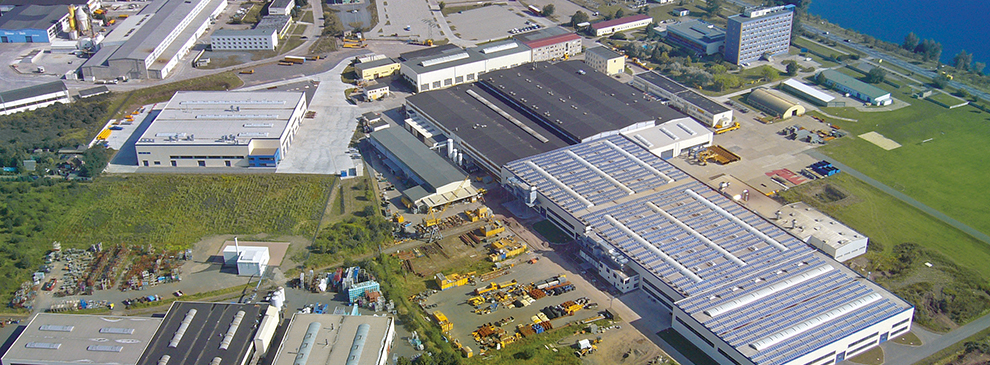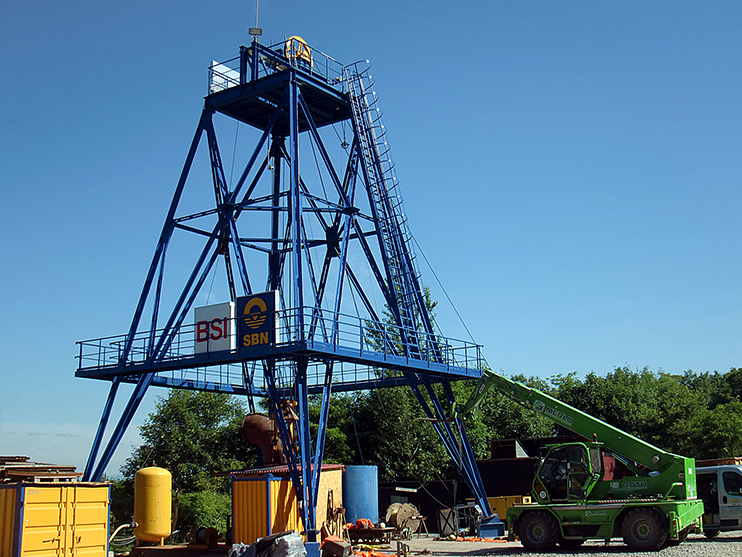Safekeeping
The old potash shaft Immenrode in the Immenrode Mine - Ludwigshall
The Immenrode shaft was sunk from 1905 to 1908. After an eventful history of active operation, it was shut down and closed in 1955. A concrete plug was installed below the wedge ring at a depth of 300 m. Since then, a solution column has stood on the plug from an average height of 100 m. Exploratory measures in 2009 revealed that the plug was in a desolate condition and had to be classified as permeable. If the plug continued to weaken further, hydraulic or mechanical failure of the sealing structure as a whole could no longer be excluded. Also within the scope of this exploration, an excavation zone was detected in the area of the red salt clay (depth 645 m to 675 m) and widening and leaching in the filling location area of the 1st level with an extension of up to approx. 25 m in the direction of the roadway outlets. Due to the recognized danger of failure of the sealing structure from 1955 and the resulting danger to the surface, the Immenrode shaft had to be re-commissioned at short notice in accordance with the rules and guidelines applicable today.
After opening and draining the shaft, the existing guide pipe string was first removed using cutting charges and a mobile crane. Up to the existing plug at a depth of 300 m, the shaft was already free of installations, so that after the head safety had been established, the dismantling of the plug could begin immediately. The clay sealing above the plug was cut off with a spade and removed with buckets. The actual concrete plug was broken out by drilling and blasting and also transported away with buckets. After the demolition of the formwork platform of the plug, the shaft was free and the scaling of the shaft guide fittings still existing underneath the plug could be tackled. This work was accompanied by the investigation of the support condition by means of exploratory drillings and local securing with anchors and shotcrete. The cavity contour for the new sealing element to be installed in the depth range of 606 m to 620 m was manually dwindled and also secured.
Backfilling of the shaft began with the installation of hard rock rubble between the 1st level and the base of the new sealing element (depth range 620 m to 792 m). As it was not possible to investigate the condition of the excavated material below the 1st level, a stable, double truncated cone counter bearing was installed for the new sealing element, so that any subsidence of the underlying backfill column could have no influence on the sealing. The sealing itself was designed as a combined mastic asphalt-clay-mastic asphalt sealing, each with a protective layer of cohesive material 0/2 above and below. The construction of the shaft gate was completed with the installation of a 5 m thick packing layer consisting of a cohesive mixture of hard rock gravel and dams.
Above the resulting depth of 581 m, further backfilling was carried out up to the surface with the alternated installation of gravel 16/32 and sand 0/2. The gravel is placed 50 m high, followed by a 15 m high layer of sand. Once the 29 m depth was reached, the working platform was removed and parts of the cableway system dismantled in order to then backfill the remaining 29 m.
Now that the shaft has been completely backfilled, the shaft head frame has been dismantled in order to gain site clearance at the shaft head. The existing shaft masonry was too weak in the upper part to support the final shaft cover plate. For this reason, two strip foundations were cast at the shaft head as supports, onto which the shaft cover plate made of reinforced concrete was laid in the last work step. A bronze shaft plate was also integrated into the cover plate, on which the name, years of operation, depth, diameter and centre coordinates of the Immenrode shaft, which is now finally in safekeeping, are noted.
How to find us
SCHACHTBAU NORDHAUSEN GmbH
Industrieweg 2a
99734 Nordhausen
Telephone: +49 3631 632-0
Fax: +49 3631 632-334
E-Mail: sbn@schachtbau.de
Web: www.schachtbau.de
Copyright © , All Rights Reserved

 German
German







